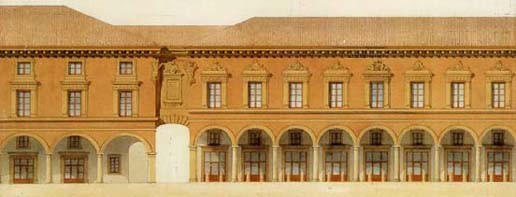The facade
In the early sixties of the 16th century, the University of Bologna was in competition with the new Italian and foreign universities, so Pope Pius IV decided to reorganize and restore its prestige: he decided to concentrate the schools of Legisti (Civil Law and Canon Law) and those of Artists (philosophy, medicine, mathematics, physical and natural science) into a single seat. Until then, the two schools were hosted in different places of the city.

The building of the "new schools" or "Archiginnasio" as it was called with a classical term, was rapidly built in a year and a half, and it was inaugurated on the 21st of October 1563. The Bolognese architect Antonio Morandi, known as "Terribilia", created a façade on two floors with a porch, which mirrors the typical features of the local architecture through the materials used, that are terracotta and sandstone.
The palace was built in an irregular space and it develops mainly horizontally, facing Piazza Galvani and the left side of the Basilica di San Petronio.
The Archiginnasio is one of the major urban renewal projects of the second half of the 16th century. The fountain of Neptune (realised in 1564), the Hospital of Death (built in 1565) and Palazzo dei Banchi (built between 1565 and 1568 and which closes the eastern side of Maggiore square) date back to those years.

Raffaele Faccioli
